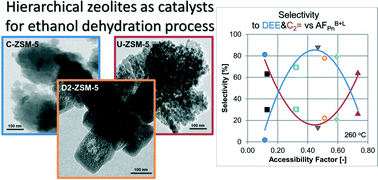Catalytic dehydration of ethanol over hierarchical ZSM-5 zeolites: studies of their acidity and porosity properties†
Abstract
The catalytic activity of novel micro/mesoporous ZSM-5 in the dehydration process of alcohols has been studied with respect to their acidity and porosity. Samples characterized by similar Si/Al ratios in the range between 23 and 36 were chosen to ensure the ability to properly monitor the changes in catalytic performance related to the concentration of acid sites, as well as their accessibility and strength. Special attention has been paid to porosity studies involving low-temperature nitrogen sorption and the quasi-equilibrated temperature programmed desorption of hydrocarbons. Thus, the wide range of materials from typically microporous ZSM-5 to micro/mesoporous analogues obtained by different methods, but presenting many similar properties, allowed us to investigate the influence of porosity character on catalytic performance. Both the acidity and porosity properties, which were significantly perturbed by various synthesis and modification strategies, were clearly reflected in the catalytic performance of hierarchical zeolites, described as volcano curve dependence.


 Please wait while we load your content...
Please wait while we load your content...